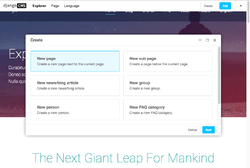django CMS
 | |
|
Screenshot  Create content with django CMS using the free open-source Explorer Theme | |
| Developer(s) | Divio AG |
|---|---|
| Initial release | May 2007 |
| Stable release |
3.4.0
/ 15 September 2016[1] |
| Development status | Active |
| Written in | Python |
| Operating system | Cross-platform |
| Platform | Django |
| Type | Content management system |
| License | BSD licenses |
| Website |
django-cms |
django CMS is a free and open source[2] content management system platform for publishing content on the World Wide Web and intranets. It is written in Django,[3] and Python.[4]
History
django CMS 1.0 was created by Thomas Steinacher.
django CMS 2.0 was a complete rewrite of the system by Patrick Lauber, itself based on a fork of django-page-cms.
django CMS 3.0 was released in 2013.
django CMS is backed by Divio AG, a Swiss software company.
It is maintained by a team of full-time developers and open-source community members; a complete list of contributors is available.
As of 10 June 2016, django CMS 3.0 is compatible with Django versions 1.8 and 1.7.
As of 15 September 2016, django CMS 3.4 introduced a Long Term Support (LTS) release cycle.
Translations
django CMS handles multilingual content by default. Its administration interface supports several languages.
Transifex[5] is used to manage the translations of the project. The current status of the translations can be found here.
Features
- Frontend-editing
- edit all plugins within the page.
- Reusable plugins
- use django CMS plugins in your own apps.
- Flexible Plugin Architecture
- build flexible pages with a wide range of plugins.
- Search Engine Optimization
- the structure of the pages is optimized for indexing.
- Editorial workflow
- workflows for publishing and approval.
- Permission Management
- set specific rights to different users.
- Versioning
- each modification of the page will be saved. You can restore any state you wish.
- Multisites
- administer multiple websites over the same admin interface.
- Multilanguage
- support for different languages (i.e. Arabic, Chinese or Russian)
- Applications (Apps)
- add apps to different pages of the CMS.
- Media Asset Manager (MAM)
- allows you to manage all kind of assets (pictures, PDFs, videos and other documents).
See also
Notable uses
- Canonical, for the Ubuntu developer portal and Ubucon websites
- NASA on their site Flight Opportunities
- Mercedes-Benz on their site Mercedes Benz Formula 1
- Stadler Rail on their site
- Affichage on their site
- Vodafone Developer on their site
- PBS Arts on their site
- Libération on their site
- Salt (formerly Orange Switzerland) on their site
- L'Oréal on their site Men Expert l site
Notes
- ↑ "django CMS CHANGELOG". github.com. 15 September 2016. Retrieved 11 December 2015.
- ↑ "Developers". django-cms.org. Retrieved 2015-12-21.
- ↑ "Django Packages: CMS Comparison". djangopackages.com. Retrieved 2015-12-21.
- ↑ "Languages used by Django CMS". github.com. Retrieved 2009-11-17.
- ↑ "Developers". django-cms.org. Retrieved 2009-12-09. — a list of developers, and tools used.
External links
- Official website
- Official Master - Repository, Bugtracker and Wiki on GitHub
- Google Group: Official Group
- Official Avatar on Twitter

- Django page CMS, the forked project